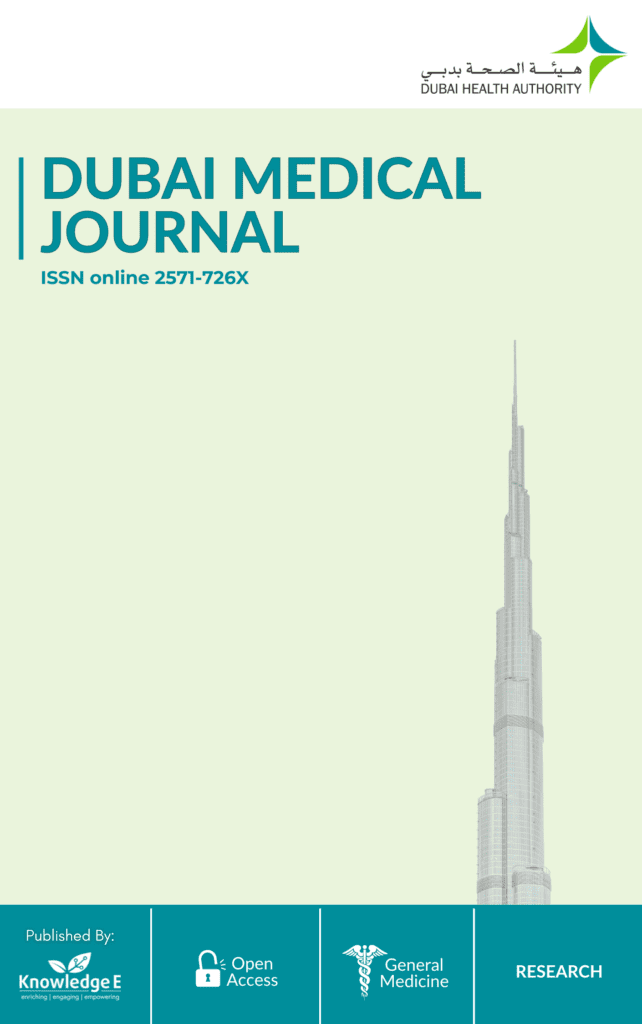
Dubai Medical Journal
ISSN: 2571-726X
Pioneering research in medicine, health sciences, nursing, pharmaceuticals, and laboratory work
Spontaneous Spinal Epidural Hemorrhage Following Intravenous Thrombolysis: A Systematic Review of Case Reports
Published date:Mar 24 2025
Journal Title: Dubai Medical Journal
Issue title: Dubai Medical Journal (DMJ): Volume 8, Issue 1
Pages:110 - 123
Authors:
Abstract:
Background: Spontaneous spinal epidural hematoma (SSEDH) is a rare condition typically occurring in adults aged between 40 and 50 years. The condition can eventually evolve into neurological deficits that result in motor and sensory loss. Tissue plasminogen activators are Food and Drug Administration-approved drugs for various vascular thrombotic diseases including myocardial infarction and acute ischemic stroke. This review seeks to examine the available literature regarding the SSEDH following thrombolytic therapy.
Method: A total of 21 papers underwent screening for eligibility criteria and subsequent evaluation led to the extraction and qualitative synthesis of data from 12 selected papers. The gathered information encompassed patients’ demographic details, primary diagnoses, types of thrombolytic therapy administered, neurological presentations, treatment modalities employed, and ultimate outcomes.
Results: This analysis delves into 13 cases of SSEDH following intravenous thrombolysis, encompassing patients aged 39 to 75 years across diverse global regions. The study revealed that eight out of 13 cases were male and nine were above 50 years old. Neurological symptoms, diagnosed via MRI or CT, manifested within 30 minutes to 48 hours post-therapy, with 76.92% occurring within the initial 24 hours. Bleeding occurrences were notably frequent across the combined cervical and upper thoracic spinal regions (cervico-thoracic), similar to their frequency in the isolated lumbar area (23.08% each). Myocardial infarction (MI) accounted for 69.2% of thrombolytic administrations.
Conclusion: Spontaneous spinal epidural hematoma is a rare but serious complication that can occur following thrombolytic therapy with tissue plasminogen activators (tPA). Our review of 12 case reports reveals that SSEDH, although infrequent, often develops within 48 hours of treatment, particularly in patients over 50. The potential link between tPA and SSEDH emphasizes the need for careful monitoring and early imaging. Further research through prospective, multicenter studies is crucial to clarify this association and enhance patient care, highlighting the importance of vigilance in managing thrombolytic therapy
Keywords: tissue plasminogen activator, spinal subdural hematoma, systematic review, CT, MRI
References:
[1] Figueroa J, DeVine JG. Spontaneous spinal epidural hematoma: Literature review. J Spine Surg. 2017 Mar;3(1):58–63. https://doi.org/10.21037/jss.2017.02.04 PMID:28435919
[2] Ogawa K, Akimoto T, Hara M, Fujishiro M, Uei H, Nakajima H. Two patients with spontaneous spinal epidural hematoma carrying a good prognosis without surgical operations. Neurol. Int. 2023; 15(1): p. 362-370. https://doi.org/10.3390/neurolint15010024.
[3] Zhong W, Chen H, You C, Li J, Liu Y, Huang S. Spontaneous spinal epidural hematoma. J Clin Neurosci. 2011 Nov;18(11):1490–1494. https://doi.org/10.1016/j.jocn.2011.02.039 PMID:21920757
[4] Ravid S, Schneider S, Maytal J. Spontaneous spinal epidural hematoma: An uncommon presentation of a rare disease. Childs Nerv Syst. 2002 Jul;18(6-7):345–347. https://doi.org/10.1007/s00381-001-0540-5 PMID:12172944
[5] Aycan A, Ozdemir S, Arslan H, Gonullu E, Bozkιna C. Idiopathic thoracic spontaneous spinal epidural hematoma. Case Rep Surg. 2016;2016:5430708. https://doi.org/10.1155/2016/5430708 PMID:27088028
[6] Lenga P, Knittelfelder M, Gülec G, Kiening K, Unterberg AW, Ishak B. Emergency surgical decompression for spontaneous spinal epidural hematoma in octogenarians: Risk factors, clinical outcomes, and complications. Acta Neurochir (Wien). 2023 Apr;165(4):905–913. https://doi.org/10.1007/s00701-022- 05457-7 PMID:36571626
[7] Schoonjans AS, De Dooy J, Kenis S, Menovsky T, Verhulst S, Hellinckx J, et al. Spontaneous spinal epidural hematoma in infancy: Review of the literature and the “seventh” case report. Eur J Paediatr Neurol. 2013 Nov;17(6):537–542. https://doi.org/10.1016/j.ejpn.2013.05.012 PMID:23786707
[8] Mu noz González A, Cuello JP, Rodríguez Cruz PM, Iglesias Mohedano AM, Domínguez Rubio R, Romero Delgado F, et al. Hematoma espinal epidural espontáneo: Estudio retrospectivo de una serie de 13 casos. Neurologia. 2015;30(7):393–400. https://doi.org/10.1016/j.nrl.2014.03.007PMID:24839904
[9] Doyle E, Britto J, Freeman J, Munro F, Morton NS. Thrombolysis with low dose tissue plasminogen activator. Arch Dis Child. 1992 Dec;67(12):1483–1484. https://doi.org/10.1136/adc.67.12.1483 PMID:1489229
[10] Marder VJ. Thrombolytic therapy: 2001. Blood Rev. 2001 Sep;15(3):143–157. https://doi.org/10.1054/ blre.2001.0161PMID:11735162
[11] Liberati A, Altman DG, Tetzlaff J, Mulrow C, Gøtzsche PC, Ioannidis JP, et al. The PRISMA statement for reporting systematic reviews and meta-analyses of studies that evaluate healthcare interventions: Explanation and elaboration. BMJ. 2009 Jul;339 jul21 1:b2700.
[12] Van Schaeybroeck P, Van Calenbergh F, Van De Werf F, Demaerel P, Goffin J, Plets C. Spontaneous spinal epidural hematoma associated with thrombolysis and anticoagulation therapy: Report of three cases. Clin Neurol Neurosurg. 1998 Dec;100(4):283–287. https://doi.org/10.1016/S0303- 8467(98)00044-4PMID:9879854
[13] Clark MA, Paradis NA. Spinal epidural hematoma complicating thrombolytic therapy with tissue plasminogen activator—a case report. J Emerg Med. 2002 Oct;23(3):247–251. https://doi.org/10.1016/S0736-4679(02)00546-2PMID:12426015
[14] Song KJ, Lee KB. The poor outcome of the delayed diagnosis of acute spontaneous spinal epidural hematoma: Two cases report. J Korean Med Sci. 2005 Apr;20(2):331–334. https://doi.org/10.3346/jkms.2005.20.2.331PMID:15832012
[15] Chan KC, Wu DJ, Ueng KC, Lin CS, Tsai CF, Chen KS, et al. Spinal epidural hematoma following tissue plasminogen activator and heparinization for acute myocardial infarction. Jpn Heart J. 2002 Jul;43(4):417–421. https://doi.org/10.1536/jhj.43.417 PMID:12227717
[16] García López A, Pérez Lara JM, Herrainz Hidalgo R, Puente Gonzalo E. Spinal epidural hematoma following thrombolytic therapy for acute myocardial infarction. Orthopedics. 1999 Oct;22(10):987–988. https://doi.org/10.3928/0147-7447-19991001-19 PMID:10535565
[17] Galzio RJ, Zenobii M, D’Ecclesia G. Spontaneous spinal epidural hematoma: Report of a case with complete recovery. Surg Neurol. 1980 Oct;14(4):263–265. PMID:7434194
[18] Markham JW, Lynge HN, Stahlman GE. The syndrome of spontaneous spinal epidural hematoma: Report of three cases. J Neurosurg. 1967 Mar;26(3):334–342. https://doi.org/10.3171/jns.1967.26.3.0334 PMID:6019740
[19] White HD, Van de Werf FJ. Thrombolysis for acute myocardial infarction. Circulation. 1998 Apr;97(16):1632–1646. https://doi.org/10.1161/01.CIR.97.16.1632 PMID:9593569
[20] Ucar EY. Update on thrombolytic therapy in acute pulmonary thromboembolism. Eurasian J Med. 2019 Jun;51(2):186–190. PMID:31258361
[21] Watson L, Broderick C, Armon MP. Thrombolysis for acute deep vein thrombosis. Cochrane Database Syst Rev. 2014 Jan;(1):CD002783. PMID:24452314
[22] Langmayr JJ, Ortler M, Dessl A, Twerdy K, Aichner F, Felber S. Management of spontaneous extramedullary spinal haematomas: Results in eight patients after MRI diagnosis and surgical decompression. J Neurol Neurosurg Psychiatry. 1995 Oct;59(4):442–447. https://doi.org/10.1136/jnnp.59.4.442 PMID:7561928
[23] Jamjoom ZA. Acute spontaneous spinal epidural hematoma: The influence of magnetic resonance imaging on diagnosis and treatment. Surg Neurol. 1996 Oct;46(4):345–349. https://doi.org/10.1016/ S0090-3019(96)00149-8PMID:8876715